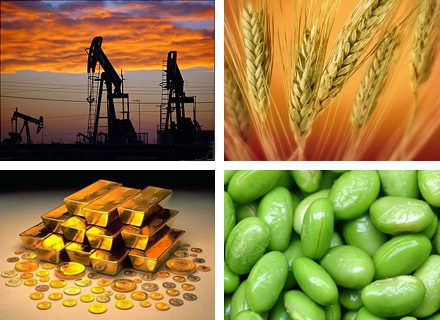In Morgan Stanley’s latest update to their Commodity Manual, the commodities team, led by Hussein Allidina, continue to be most bullish on gold, soybeans and corn. Below is their outlook for those and 11 other commodities. Words: 700
commodities team, led by Hussein Allidina, continue to be most bullish on gold, soybeans and corn. Below is their outlook for those and 11 other commodities. Words: 700
So reports Mamta Badkar (www.businessinsider.com) in edited excerpts from the original post*.
Lorimer Wilson, editor of www.munKNEE.com (Your Key to Making Money!), may have edited the article below for length and clarity – see Editor’s Note at the bottom of the page for details. This paragraph must be included in any article re-posting to avoid copyright infringement.
The Morgan Stanley report says, in part, that:
1. Brent crude oil prices…are being weighed down by new sovereign debt issues in Europe and easing global tensions on oil supply. If OPEC production continues at the current rate supply will outstrip demand in 2012.
2. Natural gas will likely be over-supplied in 2012 despite a slowdown in production. Slowing demand is however likely to build higher year-over-year inventories which will impact prices. Slowing gas-directed drilling may help tighten balances towards the end of the year.
3. Aluminum is at a surplus but high cost producers are closing capacity and because prices are lower than marginal cost.
4. Copper prices are expected to remain high because of supply side difficulties. Prices will continue to remain high until the global inventory pipeline is replenished most likely after 2014.
5. Nickel prices are linked with Chinese stainless steel production and exports, which are at risk because of a decline in industrial production. The outlook for nickel is also tied to the success of four major laterite (iron and aluminum rich oil) projects and two projects in Brazil.
6. Zinc refinery production growth is slowing but it will be a few quarters before the inventories are cleared at current demand rates. The global zinc market is oversupplied and has been so since the first quarter of 2008 and there is unlikely to be a reprieve this year. Zinc prices are only expected to perform better if China changes policy to boost construction, and if demand from Europe increases.
Take Note: If you like what this site has to offer go here to receive Your Daily Intelligence Report with links to the latest articles posted on munKNEE.com. It’s FREE! An easy “unsubscribe” feature is provided should you decide to cancel at any time.
7. Gold prices are expected to be supported by low interest rates and unconventional monetary policies. Investor demand for gold as a safe haven is likely to keep gold prices elevated…Morgan Stanley analysts expect gold to continue to be volatile.
8. Silver continues to be an attractive safe haven but is volatile, vulnerable to weakening industrial demand and weaker supply all of which make it a less supported market than gold. Investment demand in the silver market has waned of late but negative real interest rates in the U.S. are likely to be behind investment demand for silver even without another round of QE. The key risks for silver are that a weaker economic outlook in 2012 and 2013 will cut fabrication demand (manipulation of metal from one state to another), but not enough to deter production.
9. Platinum demand is at risk due to the slowdown in the global economy (jewelry and the automotive industry act as key end markets for platinum ) and decline in discretionary spending. Morgan Stanley analysts are less bullish on platinum since it lacks the safe have status associated with gold and silver and has limited investment demand.
10. Cotton‘s outlook in 2012-2013 is going to be bearish. Demand for U.S. cotton is decreasing because of higher than expected Indian exports and weak demand from emerging market textile manufacturers….
11. Sugar‘s outlook is bearish due to increased production in Thailand, Russia and India could push supplies higher and “the start of the C/S Brazilian crush should weaken prices as weak northern hemisphere demand for Brazilian raws prompts a global trade surplus into 3Q 2012.”
12. Corn inventories are low globally which should support corn prices. The USDA is unlikely however to acknowledge this soon though and a fast corn planting pace is playing into their belief of an early harvest of new crop and feeding cycle. For now all the attention is on Brazil and the health of the Safrinha crop.
13. Soybeans‘ outlook in the near-term is bullish. Weak production in South America and strong crush margins in China should support near-term demand for U.S. soybeans and soy meal.
14. Wheat is trading at a discount to corn but prices could be boosted by supply disruptions in Argentina and the Ukraine. U.S. wheat feed demand is strong but U.S. supplies can meet this demand. The pressure on U.S. wheat exports is easing because of supplies from Europe and Australia, but supply disruptions in the Ukraine and Argentina could boost wheat prices in 2013.
*http://www.businessinsider.com/here-are-morgan-stanleys-commodity-predictions-for-2012-and-2013-2012-5?op=1#ixzz1zfWGpreq (To access the above article please copy the URL and paste it into your browser.)
Editor’s Note: The above article may have been edited ([ ]), abridged (…), and reformatted (including the title, some sub-titles and bold/italics emphases) for the sake of clarity and brevity to ensure a fast and easy read. The article’s views and conclusions are unaltered and no personal comments have been included to maintain the integrity of the original article.
Related Articles:
1. Major Investment Opportunities Exist In Agriculture! Here’s 50
The agriculture sector has long been a popular place for commodity trading. After all, it was with agricultural futures that commodity trading got its start. Farmers had originally used these contracts to help offset any losses in crop yields. Now, the agricultural space has blossomed into a market chock full of options for investors, but many investors are still unaware of the vast opportunities that this sector offers. [Let us change all that!] Words : 2376
2. The “Ins” and “Outs” of Investing in Commodities
Commodities have obvious appeal to active investors looking to generate profits from short-term price movements [but while] the volatility of this asset class is ideal for risk-tolerant individuals who actively monitor their positions…commodities may also have appeal to the long-term, buy-and-hold crowd…These potentially appealing attributes come with plenty of risk, [however, as] the path to commodity exposure is full of potential obstacles and pitfalls that can erode returns and lead to a less-than-optimal investing experience. Here are ten rules of thumb that will help you achieve a more successful experience investing in commodity markets. Words: 2871
3. Jim Rogers: Stop Buying Gold! These Other Commodities are a Better Buy!
Jim Rogers is one of the most successful investors of all-time…and he buys value. Back in 1999, he predicted that a “supercycle” commodity bull market would see raw material prices advancing for longer than in any previous uptrend led by gold and silver. Gold was trading near its low at $252 and silver at $4 at the time but with gold up 650% from its lows and silver with an even greater gain – obviously Rogers was right. Rogers has now stopped buying gold moving, [instead,] towards a greater commodity opportunity that he thinks offers the same kind of values that gold and silver did a decade ago. Words: 909
4. Soros and Rogers Agree: Greater Returns from Farmland Than Gold! Here’s Why
Question: What asset has appreciated more than any asset since the year 2000? Answer: Farmland – by 1,200%! [George Soros and Jim Rogers have recognized that fact and invested accordingly. Here is what you need to know to do likewise.] Words: 974
5. 7 Agricultural Stock Buying Opportunities
The Federal Reserve has guaranteed super-low interest rates for two more years – an unprecedented step to arrest the alarming decline of the stock market and the economy – and I believe the following seven agricultural stocks have been unjustly oversold and have significant upside potential. Words: 665
6. Here’s Why Agricultural Stocks Are a Better Buy!
If you think the dollar will decline further then it makes sense to buy commodity stocks and even if there is a global recovery that’s faster than we expect many commoditiy stocks will still outperform because supply is simply unable to meet the increasing demand for some of the commodities. [Let me tell you] which one(s) to buy[- and why]? Words: 1475
 munKNEE.com Your Key to Making Money
munKNEE.com Your Key to Making Money


